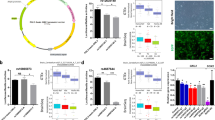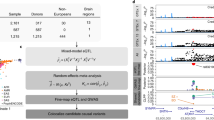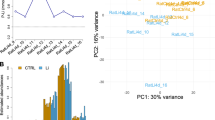Abstract
We conducted a systematic study of top susceptibility variants from a genome-wide association (GWA) study of bipolar disorder to gain insight into the functional consequences of genetic variation influencing disease risk. We report here the results of experiments to explore the effects of these susceptibility variants on DNA methylation and mRNA expression in human cerebellum samples. Among the top susceptibility variants, we identified an enrichment of cis regulatory loci on mRNA expression (eQTLs), and a significant excess of quantitative trait loci for DNA CpG methylation, hereafter referred to as methylation quantitative trait loci (mQTLs). Bipolar disorder susceptibility variants that cis regulate both cerebellar expression and methylation of the same gene are a very small proportion of bipolar disorder susceptibility variants. This finding suggests that mQTLs and eQTLs provide orthogonal ways of functionally annotating genetic variation within the context of studies of pathophysiology in brain. No lymphocyte mQTL enrichment was found, suggesting that mQTL enrichment was specific to the cerebellum, in contrast to eQTLs. Separately, we found that using mQTL information to restrict the number of single-nucleotide polymorphisms studied enhances our ability to detect a significant association. With this restriction a priori informed by the observed functional enrichment, we identified a significant association (rs12618769, Pbonferroni<0.05) from two other GWA studies (TGen+GAIN; 2191 cases and 1434 controls) of bipolar disorder, which we replicated in an independent GWA study (WTCCC). Collectively, our findings highlight the importance of integrating functional annotation of genetic variants for gene expression and DNA methylation to advance the biological understanding of bipolar disorder.
This is a preview of subscription content, access via your institution
Access options
Subscribe to this journal
Receive 12 print issues and online access
$259.00 per year
only $21.58 per issue
Buy this article
- Purchase on Springer Link
- Instant access to full article PDF
Prices may be subject to local taxes which are calculated during checkout

Similar content being viewed by others
References
Egger G, Liang G, Aparicio A, Jones PA . Epigenetics in human disease and prospects for epigenetic therapy. Nature 2004; 429: 457–463.
Park PJ . Epigenetics meets next-generation sequencing. Epigenetics 2008; 3: 318–321.
Schumacher A, Kapranov P, Kaminsky Z, Flanagan J, Assadzadeh A, Yau P et al. Microarray-based DNA methylation profiling: technology and applications. Nucleic Acids Res 2006; 34: 528–542.
Feinberg AP . Phenotypic plasticity and the epigenetics of human disease. Nature 2007; 447: 433–440.
Amir RE, Van den Veyver IB, Wan M, Tran CQ, Francke U, Zoghbi HY . Rett syndrome is caused by mutations in X-linked MECP2, encoding methyl-CpG-binding protein 2. Nat Genet 1999; 23: 185–188.
Gamazon ER, Zhang W, Konkashbaev A, Duan S, Kistner EO, Nicolae DL et al. SCAN: SNP and copy number annotation. Bioinformatics 2010; 26: 259–262.
Nicolae DL, Gamazon E, Zhang W, Duan S, Dolan ME, Cox NJ . Trait-associated SNPs are more likely to be eQTLs: annotation to enhance discovery from GWAS. PLoS Genet 2010; 6: e1000888.
Nica AC, Montgomery SB, Dimas AS, Stranger BE, Beazley C, Barroso I et al. Candidate causal regulatory effects by integration of expression QTLs with complex trait genetic associations. PLoS Genet 2010; 6: e1000895.
Zhang D, Cheng L, Badner JA, Chen C, Chen Q, Luo W et al. Genetic control of individual differences in gene-specific methylation in human brain. Am J Hum Genet 2010; 86: 411–419.
Liu C, Cheng L, Badner JA, Zhang D, Craig DW, Redman M et al. Whole-genome association mapping of gene expression in the human prefrontal cortex. Mol Psychiatry 2010; 15: 779–784.
Smith EN, Bloss CS, Badner JA, Barrett T, Belmonte PL, Berrettini W et al. Genome-wide association study of bipolar disorder in European American and African American individuals. Mol Psychiatry 2009; 14: 755–763.
Smith EN, Koller DL, Panganiban C, Szelinger S, Zhang P, Badner JA et al. Genome-wide association of bipolar disorder suggests an enrichment of replicable associations in regions near genes. PLoS Genet 2011; 7: e1002134.
Wellcome Trust Case Control Consortium. Genome-wide association study of 14 000 cases of seven common diseases and 3000 shared controls. Nature 2007; 447: 661–678.
Kato T, Iwamoto K, Kakiuchi C, Kuratomi G, Okazaki Y . Genetic or epigenetic difference causing discordance between monozygotic twins as a clue to molecular basis of mental disorders. Mol Psychiatry 2005; 10: 622–630.
Petronis A . Epigenetics and bipolar disorder: new opportunities and challenges. Am J Med Genet C Semin Med Genet 2003; 123C: 65–75.
Li Y, Willer CJ, Ding J, Scheet P, Abecasis GR . MaCH: using sequence and genotype data to estimate haplotypes and unobserved genotypes. Genet Epidemiol 2010; 34: 816–834.
Li Y, Willer C, Sanna S, Abecasis G . Genotype imputation. Annu Rev Genomics Hum Genet 2009; 10: 387–406.
Johnson WE, Li C, Rabinovic A . Adjusting batch effects in microarray expression data using empirical Bayes methods. Biostatistics 2007; 8: 118–127.
Leek JT, Storey JD . Capturing heterogeneity in gene expression studies by surrogate variable analysis. PLoS Genet 2007; 3: 1724–1735.
Purcell S, Neale B, Todd-Brown K, Thomas L, Ferreira MA, Bender D et al. PLINK: a tool set for whole-genome association and population-based linkage analyses. Am J Hum Genet 2007; 81: 559–575.
Gamazon ER, Nicolae DL, Cox NJ . A study of CNVs as trait-associated polymorphisms and as expression quantitative trait loci. PLoS Genet 2011; 7: e1001292.
Hindorff LA, Sethupathy P, Junkins HA, Ramos EM, Mehta JP, Collins FS et al. Potential etiologic and functional implications of genome-wide association loci for human diseases and traits. Proc Natl Acad Sci USA 2009; 106: 9362–9367.
Bell JT, Pai AA, Pickrell JK, Gaffney DJ, Pique-Regi R, Degner JF et al. DNA methylation patterns associate with genetic and gene expression variation in HapMap cell lines. Genome Biol 2011; 12: R10.
Richards AL, Jones L, Moskvina V, Kirov G, Gejman PV, Levinson DF et al. Schizophrenia susceptibility alleles are enriched for alleles that affect gene expression in adult human brain. Mol Psychiatry 2011 (e-pub ahead of print).
Gibbs JR, van der Brug MP, Hernandez DG, Traynor BJ, Nalls MA, Lai SL et al. Abundant quantitative trait loci exist for DNA methylation and gene expression in human brain. PLoS Genet 2010; 6: e1000952.
Sasaki J, Kofuji S, Itoh R, Momiyama T, Takayama K, Murakami H et al. The PtdIns(3,4)P phosphatase INPP4A is a suppressor of excitotoxic neuronal death. Nature 2010; 465: 497–501.
Rao JS, Harry GJ, Rapoport SI, Kim HW . Increased excitotoxicity and neuroinflammatory markers in postmortem frontal cortex from bipolar disorder patients. Mol Psychiatry 2010; 15: 384–392.
Berridge MJ . The Albert Lasker medical awards. Inositol trisphosphate, calcium, lithium, and cell signaling. JAMA 1989; 262: 1834–1841.
Acknowledgements
This work was funded by 5R01MH080425 (to CL), PAAR (Pharmacogenetics of Anti-cancer Agents Research; U01 GM61393), ENDGAMe (ENhancing Development of Genome-wide Association Methods) initiative (U01 HL084715), and the Genotype-Tissue Expression project (GTeX) (R01 MH090937) (to NJC).
Author Contributions
ERG and CL conceived and designed the study. ERG and JAB performed statistical analyses. ERG and NJC provided analysis tools. ERG and CL wrote the manuscript. CL coordinated and supervised the study. LC, CZ, DZ, ESG, JRK, TAG, CMN, RM, PDS, NJS, ENS, CSB, JIN, Jr HJE, TF, DLK, WAS, WC, JR, WB, FJM, TGS, WHB, JBP, PPZ, PBM, MGM, SZ, PZ, DWC, SS, TBB, CL participated in patient diagnosis and sample collection. All authors edited and approved the manuscript.
Author information
Authors and Affiliations
Corresponding author
Ethics declarations
Competing interests
The authors declare no conflict of interest.
Additional information
Supplementary Information accompanies the paper on the Molecular Psychiatry website
Supplementary information
PowerPoint slides
Rights and permissions
About this article
Cite this article
Gamazon, E., Badner, J., Cheng, L. et al. Enrichment of cis-regulatory gene expression SNPs and methylation quantitative trait loci among bipolar disorder susceptibility variants. Mol Psychiatry 18, 340–346 (2013). https://doi.org/10.1038/mp.2011.174
Received:
Revised:
Accepted:
Published:
Issue Date:
DOI: https://doi.org/10.1038/mp.2011.174
Keywords
This article is cited by
-
Immunoglobulin genes expressed in lymphoblastoid cell lines discern and predict lithium response in bipolar disorder patients
Molecular Psychiatry (2023)
-
A higher dysregulation burden of brain DNA methylation in female patients implicated in the sex bias of Schizophrenia
Molecular Psychiatry (2023)
-
Structural variation and eQTL analysis in two experimental populations of chickens divergently selected for feather-pecking behavior
neurogenetics (2022)
-
Genetic impacts on DNA methylation: research findings and future perspectives
Genome Biology (2021)
-
Genome-wide sequencing-based identification of methylation quantitative trait loci and their role in schizophrenia risk
Nature Communications (2021)



